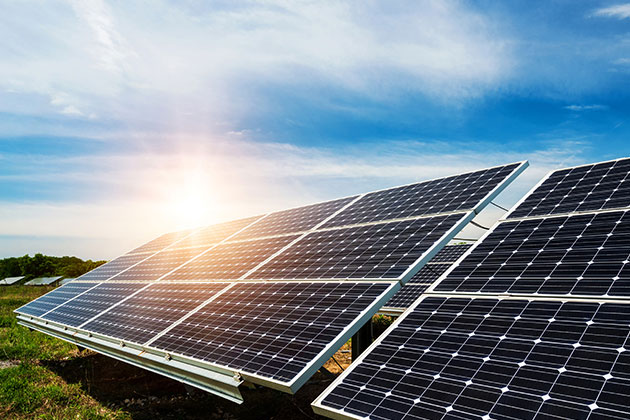Study describes a novel all-perovskite tandem saulės cell which has the potential to provide inexpensive and more efficient way to harness Sun’s energy to generate electrical power
Mūsų priklausomybė nuo neatsinaujinančių šaltinių energija vadinamas iškastiniu kuru, kaip antai anglis, nafta, dujos, turėjo didžiulį neigiamą poveikį žmonijai ir aplinkai. Iškastinio kuro deginimas padidina šiltnamio efektą ir sukelia visuotinį atšilimą, naikina buveines, teršia orą, vandenį ir žemę bei daro įtaką visuomenės sveikatai. Skubiai reikia sukurti tvarią technologiją, kuri galėtų padėti galia pasaulis naudoja švarią energiją. Saulės energija technology is one such method which has the capability to harness Sun’s light – the most abundant renewable source of energy – and convert it into electrical energy or power. The advantageous factors of saulės energy in terms of benefitting humans and environment have played a key role in promoting use of saulės energija.
Silicis yra dažniausiai naudojama medžiaga saulės ląstelių saulės kolektorių that are available in the market today. The photovoltaic process of saulės cells can transform sunlight into electricity without additional use of any fuel. Design and efficiency of silicon saulės panels has significantly improved over decades due to advancements in manufacturing and technology. The photovoltaic efficiency of a saulės cell is defined as the portion of the energy which is in the form of sunlight and which can be converted into electricity. Photovoltaic efficiency and overall costs are the two main limiting factors in saulės panels today.
Apart from silicon saulės cells, tandem saulės cells are also available in which specific cells are used which are optimized for every section of the Sun’s spectrum thereby leading to increase in overall efficiency. A material called perovskites is considered better than silicon in absorbing high-energy blue photons from sunlight i.e. another part of the Sun’s spectrum. Perovskites are polycrystalline material (generally methylammonium lead trihalide (CH3NH3PbX3, where X is iodine, bromine or chlorine atom). Perovskites are easy to process into sunlight-absorbing layers. Earlier studies have combined silicon and perovskites into solar cells i.e. having silicon cells on the top which can absorb yellow, red and near infrared photons along with perovskite cells thus almost doubling the production of power.
Naujame tyrime, paskelbtame XNUMX m Mokslas on May 3 researchers have for the first time developed all perovskites tandem solar cells which give efficiency of up to 25 percent. This material is called lead-tin mixed low-band gap perovskite film ((FASnI3)0.6 MAPbI3)0.4; FA for formamidinium and MA for methylammonium). Tin has the disadvantage of reacting with oxygen from air creating defects in the crystalline lattice which can disrupt movement of electrical charge in the saulės cell thereby limiting cell’s efficiency. Researchers found a way to prevent tin in perovskite from reacting with oxygen. They used a chemical compound called guanidinium thiocyanate to significantly improve structural and optoelectronic properties of lead-tin mixed low-band gap perovskite films. The compound guanidinium thiocyanate coats perovskite crystallites in the saulės absorbing film thus preventing oxygen from going inside to react with tin. This straightaway enhances efficiency of the solar cell from 18 to 20 percent. Also, when this new material was combined with conventionally used high-absorbing top perovskite layer, the efficiency further increased to 25 percent.
Šiame tyrime pirmą kartą aprašomas tandeminių saulės elementų dizainas, naudojant visas perovskito plonąsias plėveles, ir ši technologija vieną dieną galėtų pakeisti silicį saulės elementuose. Nauja medžiaga yra aukštos kokybės, nebrangi, jos gamyba paprastesnė, o kaina yra maža, palyginti su silicio ir silicio-perovskito tandeminėmis ląstelėmis. Perovskitai yra dirbtinė medžiaga, palyginti su siliciu, o perovskito pagrindu pagamintos saulės baterijos yra lanksčios, lengvos ir pusiau skaidrios. Nors dabartinė medžiaga turės šiek tiek laiko pranokti silicio perovskito technologijos efektyvumą. Nepaisant to, perovskito pagrindu pagamintos polikristalinės plėvelės gali sukurti tandeminius saulės elementus, kurių efektyvumas gali siekti iki 30 procentų, kartu netrukdant kitiems veiksniams. Norint sumažinti poveikį aplinkai, reikia atlikti tolesnius tyrimus, kad medžiaga būtų tvirtesnė, stabilesnė ir perdirbama. Saulės energijos sektorius yra vienas sparčiausiai augančių, o pagrindinis tikslas – atrasti perspektyvią švarios energijos alternatyvą.
***
{Galite perskaityti pradinį tyrimo dokumentą spustelėję toliau pateiktą DOI nuorodą cituojamų šaltinių sąraše}
Šaltiniai)
Tong J. ir kt. 2019 m. > 1 μs Sn-Pb perovskitų nešiklio eksploatavimo laikas leidžia efektyviai naudoti perovskitinius tandeminius saulės elementus. Mokslas, 364 (6439). https://doi.org/10.1126/science.aav7911






































